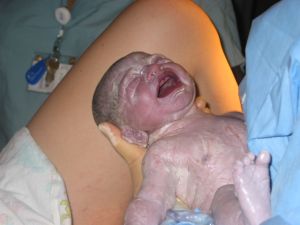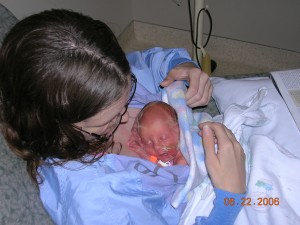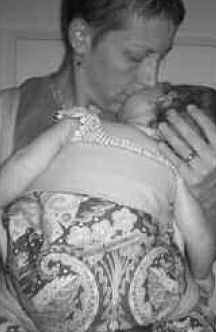From Lamaze International
 Despite best evidence, health care providers continue to perform routine procedures during labor and birth that often are unnecessary and can have harmful results for mothers and babies.
Despite best evidence, health care providers continue to perform routine procedures during labor and birth that often are unnecessary and can have harmful results for mothers and babies.
The Centers for Disease Control and Prevention’s (CDC) most recent release of birth statistics reveals that the rate of Cesarean surgery, for example, is on the rise to 31.1 percent of all births — 50 percent greater than data from 1996. This information comes on the heels of The Milbank Report’s Evidence-Based Maternity Care, which confirms that beneficial, evidence-based maternity care practices are underused in the U.S. health care system.
What the Research Says
Research indicates that routinely used procedures — such as continuous electronic fetal monitoring, labor induction for low-risk women, and Cesarean surgery — have not improved health outcomes for women and, in fact, can cause harm. In contrast, care practices that support a healthy labor and birth are unavailable to or underused with the majority of women in the United States.
Suggested Labor and Delivery Practices
Beneficial care practices outlined by Evidence-Based Maternity Care, a report produced by a collaboration of Childbirth Connection, the Reforming States Group, and the Milbank Memorial Fund, could have a positive impact on the quality of maternity care if widely implemented throughout the United States. Suggested practices include to:
- Let labor begin on its own.
- Walk, move around, and change positions throughout labor.
- Bring a loved one, friend, or doula to support you.
- Avoid interventions that are not medically necessary.
- Choose the most comfortable position to give birth and follow your body’s urges to push.
- Keep your baby with you — it’s best for you, your baby and breastfeeding.
“Lamaze is alarmed by the current rate of Cesarean surgery, and furthermore, by the overall poor adherence to the beneficial practices outlined above in much of the maternity care systems in the United States,” said Pam Spry, president of Lamaze International, www.lamaze.org. “We are continuing to work to provide women and care providers with evidence-based information to improve the quality of care.”
Lamaze International has developed six care practice papers that are supported by research studies and represent “gold-standard” maternity care. When adopted, these care practices have a profound effect –instilling confidence in the mother, and facilitating a natural process that results in an active, healthy baby. Each one of the Lamaze care practices is cited in the Evidence-Based Maternity Care report as being underused in the U.S. maternity care system.
A Need for Balance
“As with any drug, we need to be sure that women and their babies receive the right dose of medical interventions. In the United States we are giving too high a dose of Cesarean sections and other medical interventions, which are causing harm to women and their babies. Yet, there are many countries where life-saving medical interventions are under dosed, which can also cause harm,” said Debra Bingham, chair of the Lamaze International Institute for Normal Birth. “Every woman and her baby needs and deserves the right dose of medical interventions during childbirth.”
The research is clear, when medically necessary, interventions, such as Cesarean surgery, can be life-saving procedures for both mother and baby, and worth the risks involved. However, in recent years, the rate of Cesarean surgeries cause more risks than benefits for mothers and babies.
The Danger of Cesarean Sections
Cesarean surgery is a major abdominal surgery, and carries both short-term risks, such as blood loss, clotting, infection and severe pain, and poses future risks, such as infertility and complications during future pregnancies such as percreta and accreta, which can lead to excessive bleeding, bladder injury, a hysterectomy, and maternal death.
Cesarean surgery also increases harm to babies including women giving birth prior to full brain development, breathing problems, surgical injury and difficulties with breastfeeding.
About Lamaze International
Since its founding in 1960, Lamaze International has worked to promote, support and protect normal birth through education and advocacy through the dedicated efforts of professional childbirth educators, providers and parents. An international organization with regional, state and area networks, its members and volunteer leaders include childbirth educators, nurses, midwives, doulas, lactation consultants, physicians, students and consumers. For more information about Lamaze International and the Lamaze Institute for Normal Birth, visit www.lamaze.org.
 Nutritional deficiencies in mothers can affect her mental health and lead to inconsistent patterns of mother-child interactions, which in turn increases the likelihood of creating an insecure attachment between the mother and child.
Nutritional deficiencies in mothers can affect her mental health and lead to inconsistent patterns of mother-child interactions, which in turn increases the likelihood of creating an insecure attachment between the mother and child. Dear Readers,
Dear Readers, A University of Maryland study shows that, more than marriage, involving the father during the prenatal period leads to a stable family life.
A University of Maryland study shows that, more than marriage, involving the father during the prenatal period leads to a stable family life. Despite best evidence, health care providers continue to perform routine procedures during labor and birth that often are unnecessary and can have harmful results for mothers and babies.
Despite best evidence, health care providers continue to perform routine procedures during labor and birth that often are unnecessary and can have harmful results for mothers and babies.


 Becoming a mother can be wonderful – and highly stressful. Sleepless nights, breastfeeding difficulties, a history of trauma, low partner support, or a baby with health problems are all stressors that can put you at risk for depression. Fortunately, there are some steps that you can take to help you cope.
Becoming a mother can be wonderful – and highly stressful. Sleepless nights, breastfeeding difficulties, a history of trauma, low partner support, or a baby with health problems are all stressors that can put you at risk for depression. Fortunately, there are some steps that you can take to help you cope. So many first-time moms are caught off-guard by their emotions after giving birth to the baby they’ve been waiting for months, even years, to join their family. It’s completely normal to feel a letdown after the big day. After all, childbirth is a life-changing experience in every way. What new moms and their partners need to do is understand how to recognize the “baby blues” and what can help until they go away…usually in a couple weeks.
So many first-time moms are caught off-guard by their emotions after giving birth to the baby they’ve been waiting for months, even years, to join their family. It’s completely normal to feel a letdown after the big day. After all, childbirth is a life-changing experience in every way. What new moms and their partners need to do is understand how to recognize the “baby blues” and what can help until they go away…usually in a couple weeks.